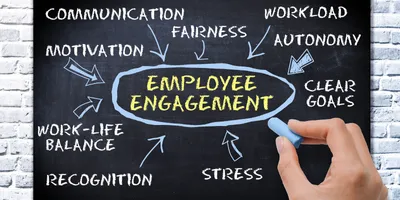Employee engagement is critical to business success, yet many companies struggle to create and sustain an engaged workforce. A major disruption to engagement is the unhappiness epidemic spreading across many workplaces. When employees feel disconnected, unmotivated, or undervalued, their performance declines and turnover rates increase.
To foster engagement, companies must understand what truly drives employees. Studies show that engagement stems from feeling connected to the company’s mission, trusting leadership, and experiencing meaningful work. However, several myths about engagement prevent organizations from implementing effective strategies. Below, we address six common myths that undermine engagement and provide insights into what truly works.
1. A Flexible Work Environment Fosters Productivity
While remote and flexible work arrangements offer numerous benefits, they are not automatically linked to higher productivity. One of the biggest challenges of remote work is the lack of day-to-day interaction, mentorship, and knowledge-sharing that naturally occurs in an office setting. Many remote employees report feeling isolated, overlooked for promotions, and disconnected from company culture.
How to Improve Engagement in Remote Work:
- Establish structured check-ins with managers to provide feedback and support by scheduling regular one-on-one meetings, performance reviews, and informal catch-ups. This helps managers identify challenges early, offer guidance, and strengthen relationships with remote employees.
- Create virtual spaces for informal communication and team bonding through dedicated Slack channels, virtual coffee chats, and online team-building activities. Encouraging social interaction fosters a sense of belonging and combats isolation.
- Implement mentorship programs to ensure professional development continues outside the office by pairing new hires and junior employees with experienced mentors. This helps employees gain insights, receive career guidance, and stay engaged in their roles.
- Use collaboration tools to maintain transparency and team cohesion by leveraging project management platforms, shared digital workspaces, and video conferencing tools. Providing clear documentation, expectations, and workflows ensures smooth communication and collective accountability.
By integrating remote employees into the daily rhythm of the organization, companies can maximize productivity while maintaining engagement.
2. Strong Paychecks Equal Strong Loyalty
While competitive salaries are important, money alone does not guarantee employee loyalty. Research indicates that only 20% of employees are primarily motivated by financial incentives, while the other 80% seek purpose, career growth, and emotional connection to their work.
What Employees Value Beyond Money:
- Opportunities for continuous learning and skill development by providing employees with access to upskilling programs, workshops, and industry certifications. Encouraging lifelong learning fosters adaptability and career growth.
- Challenging and rewarding projects that enhance their expertise by assigning tasks that push their skills and encourage creative problem-solving. Offering stretch assignments and leadership opportunities keeps employees engaged.
- A sense of belonging and contribution to a meaningful mission by ensuring employees see how their work impacts the organization’s success. Promoting team collaboration, diversity, and inclusive work environments strengthens employee connection and commitment.
- Recognition and appreciation for their efforts through structured rewards programs, verbal praise, and performance-based incentives. Regular acknowledgment of contributions, both big and small, reinforces motivation and job satisfaction.
Companies that only rely on financial incentives to retain employees may find themselves in constant bidding wars with competitors. Instead, a holistic engagement approach—offering growth, connection, and purpose—creates lasting commitment.
3. Employee Independence is Necessary for Performance
While autonomy can boost creativity and efficiency for some employees, not everyone thrives in an independent work environment. Some employees require structure, guidance, and frequent collaboration to remain engaged.
Balancing Autonomy and Support:
- Provide clear expectations and structured projects for employees who need direction by setting measurable goals, defining success criteria, and offering consistent feedback. Having a clear roadmap helps employees feel secure and confident in their roles.
- Offer flexibility for those who excel in independent roles by allowing them to manage their tasks with minimal oversight, set their own schedules where possible, and provide opportunities for remote or hybrid work arrangements. Flexibility should be balanced with accountability to ensure productivity remains high.
- Encourage regular team interactions to foster camaraderie and prevent isolation through scheduled team meetings, collaborative projects, and informal social events. Encouraging employees to engage in both professional and casual conversations strengthens team bonds and enhances overall workplace morale.
- Train managers to recognize different work preferences and adjust leadership styles accordingly by providing management training in emotional intelligence, communication strategies, and adaptive leadership. Understanding the needs of diverse employees ensures that each individual receives the right level of guidance and autonomy to thrive.
Engagement improves when employees receive personalized support that matches their work style.
4. A Job is Just a Job
Today’s workforce expects more than just a paycheck—they seek meaningful work that aligns with their personal values. Employees want to know that their contributions matter and that their work has a greater impact.
Creating Purpose in the Workplace:
- Communicate how each employee’s role contributes to the company’s success by clearly defining their impact on company goals, customer satisfaction, and overall business growth. Regularly highlight individual and team achievements to reinforce their contributions.
- Encourage community involvement and corporate social responsibility initiatives by organizing volunteer opportunities, matching charitable donations, and supporting causes that align with company values. Employees who feel connected to a purpose beyond their daily tasks tend to be more engaged and motivated.
- Recognize employees’ work in ways that emphasize impact and contribution through structured recognition programs, personalized appreciation, and awards for outstanding performance. Publicly acknowledging efforts, whether in meetings, newsletters, or company-wide events, helps build a positive and motivating work environment.
- Foster a culture of innovation and problem-solving, where employees feel empowered to make a difference by encouraging brainstorming sessions, cross-functional collaborations, and open forums for sharing ideas. Providing resources and incentives for innovation can drive creativity and engagement across teams.
When employees see their work as meaningful, engagement and job satisfaction soar.
5. Employees Should be Satisfied with Their Current Position
Many organizations assume that if an employee is content in their current role, engagement will remain high. However, lack of growth opportunities is a leading cause of disengagement. High-performing employees need a clear career pathway and opportunities for advancement.
How to Provide Growth Opportunities:
- Offer training programs, workshops, and certifications to enhance skills by providing employees with access to ongoing education, technical skill-building, and leadership development courses. Encourage participation in industry conferences and specialized certifications to foster professional growth.
- Provide mentorship and leadership development for high-potential employees by pairing them with experienced mentors who can offer career guidance, industry insights, and professional networking opportunities. Structured mentorship programs help employees develop leadership skills and prepare for future roles.
- Encourage internal promotions and cross-functional projects to diversify experience by creating opportunities for employees to take on new challenges, collaborate across departments, and expand their skill sets. Implement job rotation programs to help employees explore different functions within the company.
- Regularly discuss career goals and future opportunities with employees through one-on-one check-ins and performance reviews. Providing clear pathways for career advancement and aligning employee aspirations with company objectives ensures long-term engagement and retention.
When employees feel that their company invests in their long-term growth, they are more committed and engaged.
6. Your Company is Enough to Keep the Employee
Many businesses assume that a strong brand and good reputation are sufficient to retain top talent. However, research shows that employees don’t leave companies—they leave managers. A poor relationship with direct supervisors is one of the top reasons employees quit.
How to Build Strong Manager-Employee Relationships:
- Train managers to provide meaningful feedback, recognition, and support by implementing structured performance reviews, regular one-on-one meetings, and immediate acknowledgment of contributions. Constructive feedback helps employees stay motivated and aligned with company goals.
- Encourage open communication and active listening between leadership and employees by fostering a culture where employees feel safe expressing their opinions and concerns. Implement anonymous feedback channels and town hall meetings to address company-wide matters transparently.
- Ensure that managers delegate meaningful assignments and invest in employee development by providing opportunities for skill-building projects, cross-departmental collaboration, and leadership training. Employees should feel challenged but supported in their growth.
- Create a culture where employees feel valued, respected, and heard by implementing recognition programs, celebrating achievements, and emphasizing inclusivity in decision-making. Employees who feel appreciated are more engaged and committed to their work.
Employees stay engaged when they have strong, supportive leadership that fosters professional growth and appreciation.
Building a Sustainable Employee Engagement Strategy
While salary, flexibility, and autonomy are important, they are not standalone solutions for employee engagement. Companies must focus on alignment, meaningful work, strong leadership, and career growth opportunities to create an environment where employees feel valued, motivated, and committed.
Lab Quality Management Certificate
The Lab Quality Management certificate is more than training—it’s a professional advantage.
Gain critical skills and IACET-approved CEUs that make a measurable difference.
Key Takeaways for an Effective Engagement Strategy:
- Prioritize human connection by integrating remote workers and fostering teamwork.
- Offer more than financial rewards—invest in professional growth and emotional connection.
- Balance autonomy and support to meet different work preferences.
- Emphasize purpose and meaning in day-to-day tasks.
- Create clear career pathways to retain high-performing employees.
- Develop strong leadership that fosters employee appreciation and growth.
When organizations move beyond these six myths and implement a personalized, thoughtful engagement strategy, they unlock higher productivity, increased retention, and a more motivated workforce.













